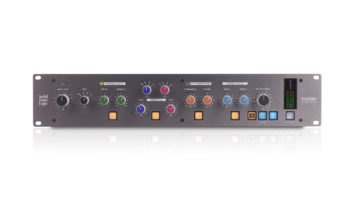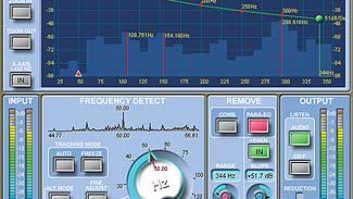Lots of people are predicting the death of digital tape. I’ll spare you the Mark Twain quote, but digital tape machines — whether as DASH multi-tracks or cassette-based MDMs — are still here, and with plenty of them in the field, they should be around for some time to come. Just out of diapers, workstation technology is a work in progress. I love my workstation, but nothing beats the convenience of popping in a tape and pressing Play.
Many of the new hard disk recorders (such as the Fostex D2424 reviewed in this issue) are cool because — as dedicated devices — they behave like tape machines, only faster. Random access has made rewind and fast forward obsolete, locating is instantaneous and looping a piece of cake. Hard drives are super-affordable now — ironically, all that storage technology costs about the same as a reel of 2-inch tape, and these days, a 20GB hard drive can cost less than a pair of decent Sony headphones! Short-term storage is affordable, but DVD — the most logical long-term storage — is not yet the cheap fast food that CD-Rs have become.
Whenever data is being exchanged — through wire, Ethernet, disc or tape — there is a minimum quality required to deliver an uncompromised signal. I call the usable information above the minimum, “data headroom.” You want headroom in both the analog domain and in the digital domain — to avoid clipping and the nasty hash, respectively. Digital tape, CDs and DVDs are capable of maintaining the data stream even with dropouts, fingerprints and scratches. Redundant data is encoded into the stream to make the process more robust.
That said, the challenge of squeezing more information into the same physical space places more emphasis on the medium and ultimately its relationship with the transport. For example, a 16-bit DTRS user may find that a 24-bit machine may have its own tape preference.
At one time, some early DA-88s did not perform well with Fuji (and TDK) tape until a resistor change made the machine more tolerant. Now, Tascam ships Fuji DPD Series Metal Particle tape with its 24-bit MDMs. In between, Tascam approved a formulation for tape manufacturers, allowing them use of the DTRS logo and making the choice easy for the end-user. Maxell tape works well also. Still, I was curious to know whether there was much difference between Fuji tape and the other previously approved DTRS formulations.
SOUND CHECK
Checking the Error Rate is the best preventive maintenance because it clearly indicates the amount of data headroom available. Figure 1 is a composite of three images. At the top, three buttons are labeled 1, 2 and 3. Press Shift, then Menu and continue pressing Menu until “Maintain” appears. Then press Submenu until “bEr” appears using the up/down buttons to select “On.”
The Block Error Rate (bEr) is displayed using the LED meters: A-head on 1, 3, 5 and 7; B-head on 2, 4, 6 and 8. The meters are only accurate when the machine is in Playback mode. From Stop to Playback, the meters will peak, then settle. If no LEDs light up, then there is plenty of data headroom; an occasional flicker could indicate tape dropouts. The example shown in the lower half of Fig. 1 shows three LEDs consistently lit. This indicates that something is compromising performance, though not enough to illuminate the PB Condition LED.
Note: The PB Condition LED is on when bEr-on is displayed and the Shift LED is illuminated. Press Shift and the machine stays in bEr mode, the eight-bargraphs display tape errors and the PB Condition LED toggles on and off. When bEr is off, the PB Condition LED should be off 99.99% of the time. A major dropout might flash the LED, but it is mostly there to tell you when it’s too late.
The middle of Fig. 1 also features a “geek insert,” a view of the RF envelope (the signal from tape) on top of which are error flags derived from pin-2 of TP-1509. The errors are from the same tape that consistently lit the LEDs below. Anyone familiar with the RF envelope will know that this one looks quite good, yet something is wrong that will eventually cause a problem. If you are nontechnical and stop reading now, just remember that any lit LED segments (when in bEr mode) are a sign you should stop. Do not attempt an overdub. Clean the heads, clone the tape and check error rate again.
SOLVING THE MYSTERY
There are two ways to tackle the mystery tape issue: user and geek. Users should try any of the available DTRS tapes — new stock only — knowing that all of them have a similar characteristic. I tried a brand-new BASF/EMTECDA-30 MP on the DA-78HR in 24-bit mode with excellent results.
The short story is this: Tape is made from rust, glue and plastic, each possessing potentially variable properties. Tape heads are remarkably complex devices that are also subject to manufacturing tolerances. If “optimum” is the middle of the specification, then a tape that is left of center and a machine that is right of center could trigger the error LEDs.
Warning: Readers who don’t comprehend geek-speak may skip the next section, but should at least read the last paragraphs of the article.
Geeks and the curious should take a closer look at the RF signals in Fig. 2. Set the horizontal sweep as far as it will go (at least 0.1μS/div) and trigger on the incoming signal at TP3 and TP4. (This test does not require an external trigger.) The difference between the 16-bit and 24-bit eye patterns clearly demonstrate the amount of additional information being squeezed onto the tape. (The “eyes” are the dark spots.) The brighter low-frequency is 3.15 MHz, recorded when formatting. The data in the background is 6.3 MHz. Adjusting the playback EQ — R53/54 for MP, R51/52 for ME tape — should enhance the eye pattern; the 3.15MHz signal should also be square and not tilted.
BIGGER IS BETTER
From right to left, Fig. 3 shows the progression of increased signal (to and from tape) from the birth of DTRS through the present. Each vertical division represents 500 mV. My ancient Tascam Test Tape, MTT-88101, is on Sony stock. Notice how its envelope (at right) falls below 1,000 mV. The DTRS stock in the middle, recorded on the DA-78HR, “kisses” the window, while the Fuji stock (also recorded on the DA-78HR) exceeds 1,000 mV in a healthy way.
Increased output level is one way to improve data headroom. A clear “eye” pattern is another, relying on the quality of the head gap plus a little EQ. The answer to the mystery tape question was a batch of Sony DARS-113MP. It wasn’t new stock, and it must have been just a little harder to erase than the EMTEC stock. I experimented with record current with the adjustments at near-maximum. Turning them all the way up just about made the LEDs go away completely. Then I tried Fuji stock, turning the record current down to simulate the reading of the mystery tape. The Fuji tape requires less record current even when blasting away previously recorded material.
MORAL OF THE STORY
Check error rate before a session. It’s the only way to weed out potential problems — machine or medium — especially those caused by tolerance issues. Mass production lives and dies by its ability to stay within specified tolerances — that’s what ISO-9000 certification is about, though you don’t often see it touted in our industry. For all machines that have dual-resolution capability, a problem in High-Res mode may not exist in Standard mode. Proving this is another way of confirming the available data headroom.
Many people ask me if it’s okay to recycle tape. For both digital and analog, the ability to reuse tape is based on the machine’s record and erase current, respectively, combined with head efficiency. Panasonic DAT recorders are most vulnerable, especially those made after 1994 (or if the heads have been replaced). Try recording over previously recorded material comparing a Sony DAT against a Maxell DAT, checking error rate before and after. It might convince you to keep buying new tape.
Eddie thanks: Phil Sanchez at Tascam for use of the DA-78HR, Jean Tardibuono and Natalie Stocker at EMTEC for their tape stock, and John Calder of Heartland Marketing for the Fuji tape stock.
By the time you read this, Eddie will be a daddy for the second time. Visitwww.tangible-technology.comfor pictures.






